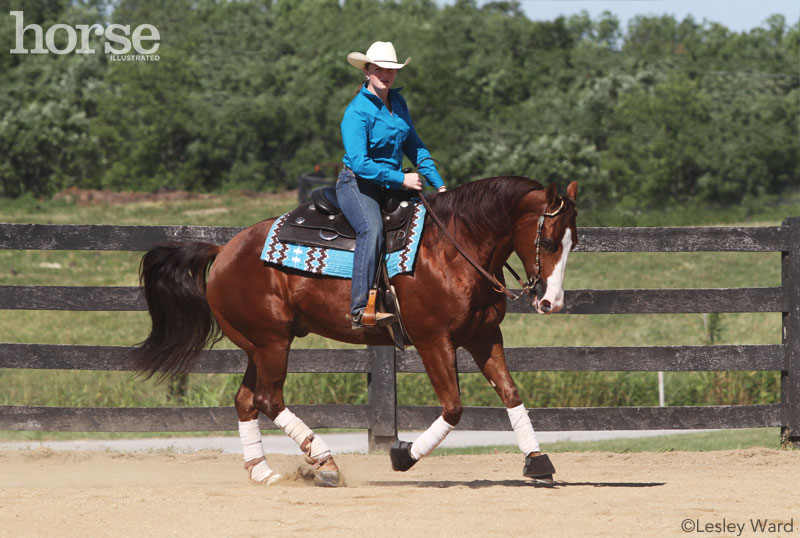
Eyes Up
You’ve heard, “Look where you want your horse to go,” but how often do you actually do that? Though it might seem like overused advice, there’s a great deal of substance behind it. Panella, a trainer and judge from Mukwonago, Wis., says the simple act of looking down can be throwing off your ride.
“Keep your eyes up,” says Panella. “Not only does it help to look where you’re going, but it also helps your balance, which helps your horse’s balance. The more correct you are, the more correctly your horse is going to travel.”
She points out that riders most often look down at the horse’s shoulder when asking for a lead or when making a turn.
Exercise: To help counteract leaning, Panella suggests putting a little extra weight in the outside stirrup and keeping your eyes up. You know your horse is underneath you, so feel what he is doing instead of looking.
Ride with Your Legs
Clibborn, a natural horsemanship trainer from Milton, Wis., says many riders he works with resort to their hands to pull and control the horse instead of guiding them with leg pressure.
“Horses move away from pressure, but riders seem to want to balance their horses off their hands and drive straight from the bit,” says Clibborn. “There are a lot of horses that are real heavy in their front end because they can’t get off their own shoulders.”
Exercise: When you correct your horsemanship, you should see a change in your horse’s way of going.
Try these exercises to teach yourself to use more leg and less hand:
Clibborn sets four or five barrels (you can use cones if you don’t have barrels) at 15-foot intervals and asks his riders to cue their horses to weave through from a leg-yield. Leg-yield to the right, allow your horse three or four steps straight past the barrel, then leg-yield left. This exercise will teach the horse to move off your leg instead of leaning into the bit and dropping his shoulder.
Do pivots at the walk to isolate the shoulder. Start at a walk along the rail, and then ask for a 90-degree turn using your leg. Return to a place down the rail and repeat. Once your horse is consistently moving off your leg for the 90-degree turn, try 180-degree turns. After several lessons, ask for a 270 and then 360.
“You have to slow down to get it,” says Clibborn. “People want the results now, but the horse says, ‘You have to teach me.’ The horse knows how to do anything you want, but you have to learn to communicate it.”
Take a Seat
If your muscles are strained, your calves are tired or your back is sore, chances are you are forcing your seat or you’re out of balance. Horsemanship riders often sit very upright with arched backs. Not only does this position look uncomfortable for the rider, but the stiffness is also irritating to the horse.
“Think about sitting on your pants pockets so you’re sitting really nice and deep into the horse,” says Panella. “But you don’t want to go back so far that you’re sitting on the cantle.”
Some riders also tend to brace against the stirrups. Sit deep, pull your stomach back, have some bend in your knee and keep your heels down. If your stirrups are too long and you’re dropping your toes, your leg is ineffective. If your stirrups are too short, you will be standing up in the saddle.
Exercise: Whether you’re guilty of arching your back or you just need to improve your balance, Panella recommends two English-riding techniques: riding in a two-point position and posting at the trot.
A two-point is a more forward jumping position where your seat is elevated out of the saddle with your weight in your heels. This exercise is a little challenging, but really works on the rider’s balance. You should focus on creating a straight line from your ear to your shoulder, through your hip and down to the back of your heel. Let gravity pull your heels down.
While trotting, posting is when the rider rises in the saddle in time with the horse’s stride. In western disciplines, riders often like to post during training to teach their horses to move out. But Panella has her students post to practice timing and balance and to teach the rider to feel the horse’s legs moving underneath them.
Another helpful exercise to correct your seat is to ride without stirrups. Instead of letting your legs hang loose, though, focus on that alignment from ear to heel. Sit down on your pockets, have a slight bend in the knees and relax your thighs. Avoid leaning forward and gripping with your knees.
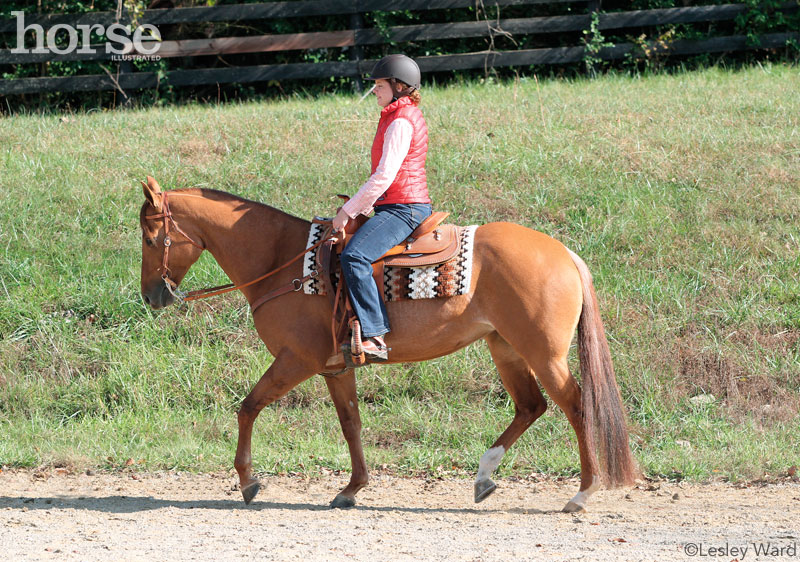
Ride Relaxed
We’ve all been told that horses feed off of our energy, so why ride when we’re tense? Clibborn says the easiest way to have a bad ride is to get on when you’re stressed. “You should be able to ride your horse like you’re sitting in your armchair,” he says. “You should be that relaxed when riding. Most people are tense. If you’re tense, your horse will feel it.”
When you come out to the barn to ride, give yourself plenty of time. “You can’t be around horses and be in a rush,” says Clibborn.
Your tension might be causing you to grip the horse with your legs instead of hugging him with them. You have to let off the pressure in order to give effective cues. Also, your stressed-out temperament could be the reason behind your horse’s increasing speed.
“I have a client with a high-tension job,” says Clibborn. “Her mind is racing. When she’s doing a rising trot, she’s 10 times faster than the horse. If you want your horse to slow down, you’ve got to slow down. If you want your horse to speed up, you speed up. It’s that simple.”
To remedy a racing mind and a speedy horse, Clibborn suggests riders practice four speeds at the walk, three speeds at the trot and two speeds at the canter by simply thinking slow and slowing your body. Practice those things so you can slow your horse to a crawl or pick him up to a fast pace.
Exercise: Set up ground poles to ride over to encourage you and your horse to think. If you’re going too fast, set the poles closer and think “slower.”
Forget the Fads
Fads are often more about style than substance. Panella says a recurring trend is to ride with open fingers, only passing the reins through the fingertips, to show how lightly the horse can be ridden. Not only is this unsafe if you’re not a professional in an enclosed space, it’s not an effective tool of communication to your horse.
Ride Your Horse
Be a rider every time you get on your horse. Even if you’re just out on the trail, pay attention to your surroundings and to your mount. Horses are flight animals, so their first reaction to a tree branch snapping is to take off. Being constantly engaged will make you a better rider and will keep your horse focused on the task at hand.
“There are a lot of trail riding mistakes that people can make,” says Clibborn. “They don’t think that they’ve actually got to ride their horse down the trail. It’s too late once the deer jumps to wake up. Be prepared for anything out there and you’ll stay safe on your horse.”
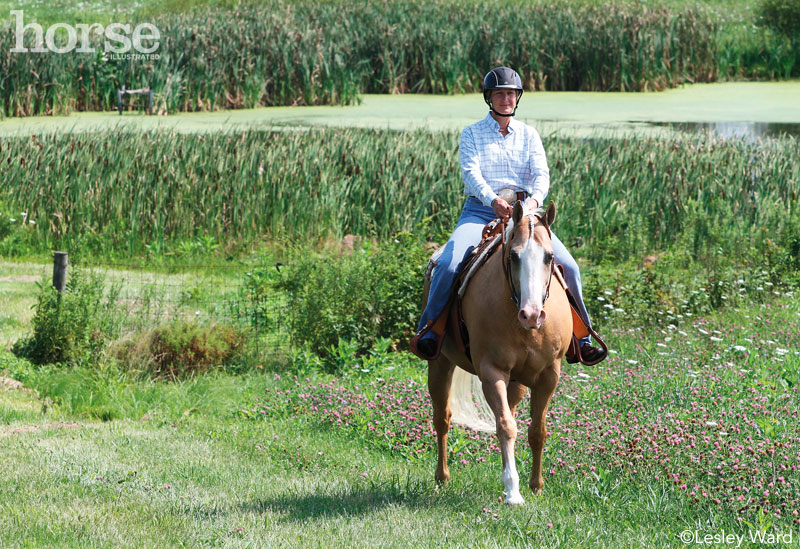
‘
Mix it Up
Are you on the fence about leaving the rail? Working on the rail can make your horse very one-sided. Panella says you can easily sour a horse to the rail if you don’t give him a change of scenery or mix up his exercise routine.
“It’s a complete safety net for a lot of people, and they really get trapped into that,” she says.
When you leave the fence, you must work to control both sides of the horse, whether you’re in the arena or out on a trail. Panella suggests working in an open field or coming into the center of the arena to work on transitions, patterns and poles. Give your horse a job.
Exercise: When using poles, start at a walk. Aim for the center of the pole and look past it. Feel the horse lifting his body and stepping over the pole. This helps you work on balance and teaches your horse to use his body and pick himself up. Avoid using PVC ground poles, though; they can shatter when stepped on by a horse.
A change of scenery is also good for you and your horse. Instead of sticking to a rail, ride over and through obstacles. Get out of the arena and allow your horse to work on different terrain.
Have an Extra Set of Eyes
Even if you’re DIYing your rides, you can still use an extra set of eyes. Set up a video camera and record your equitation. Look at your leg position. Can you draw a straight line from your ear through your shoulder, hip and heel? Are you leaning when asking for a lead or coming around a corner? How are your hands and your seat? Give yourself an honest evaluation.
Have a Checklist
Even on a casual ride, you should have something to work on. The more you practice your communication with your horse, the more effectively you’ll work together. Panella says what works best for her and her students is to put together a checklist.
“In your checklist, ask yourself, ‘How am I riding?’” says Panella. “‘Am I looking ahead? Is my foot underneath me? Am I breathing?’ Have some fun with it and relax.”
Put it Together
“All these little things you do really add up to the whole picture of good riding,” says Panella. “A good rider is not just a pretty rider. Correct position is going to help you be a more effective rider, and that’s what you should be striving for.”
A freelance writer from Woodstock, Ill., LISA KUCHARSKI enjoys recreational trail riding and competing in open pleasure shows.
This article originally appeared in the March 2015 issue of Horse Illustrated magazine. Click here to subscribe!

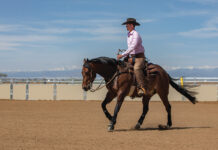
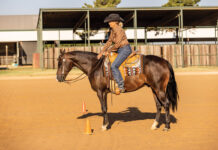
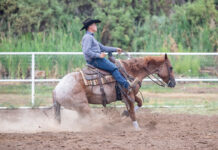

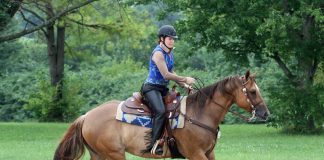

I’m learning a lot from the internet about training and working with horses yet when I run across terms I do not understand the time spent has been wasted. Not in this case as all terms have been explained. TY.
Thank you, thank you, thank you. This is one of the best if not the best article with practical tips I have read so far. I can relate and can’t wait to incorporate this tips into my practice routine.
this article is helping me with my senior project and its changing how i ride to thank you so much for the great pointers it changed how my horse moved and now we are the number one pointer in my county.
When I read these, I think about myself becoming a better rider. However, I am told to do just western riding. I’d like to do both English and western.